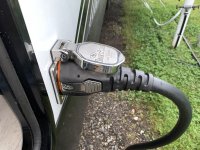We've been stationary in Florida from early February until July 4th when we hooked up the Big Country to head west to visit family. When I unhooked our 50 Amp cord from the trailer, I was a little dismayed to see that one of the terminals on the shore cord end was darkened.

Since we would be on the road for 10 days, there wasn't much I could do about it immediately. Besides, looking into the socket on the outside of the trailer the corresponding terminal looked clean. I did order a SmartPlug socket and cord end kit from Amazon to be delivered to our family at our destination in Washington state.
I installed everything today. I started with the trailer connector socket first to make sure I didn't run into any problems (I didn't). There was enough extra cord to pull out pretty far.


I disassembled the trailer socket. Here's where things got interesting. Looks like the red wire got pretty hot. Also note some green corrosion.

After removing the wire from the old socket, I cut it back about 4-5 inches and prepared it again for the new socket, making sure I had good, clean wires.

I left the socket hanging for later testing and turned to the shore power cord. I used a hacksaw to cut the end off and trimmed back the outer insulation and cut off the appropriate amount of insulation from each wire.


I didn't take pictures during assembly, but here's the final cord end.

And here it is plugged into the rig (after testing). Note that there are two silver squeeze to release latches on the side of the plug and the socket cover also serves to hold the cord in place.


I tore down the old trailer socket a bit more. Here's more of the carnage caused by the overheated contact.

Part of the moral to this story is if you are sitting still and using your RV for long periods of time (we're full-time), maybe take a few minutes every month or two and unplug your shore power to check for any burning.
Note that we have an EMS that is hardwired into our trailer just before the breaker box inside. I do have the voltage monitor and check it regularly for voltage drop under load (indicative of a bad connection) and really never saw anything suspect.

Since we would be on the road for 10 days, there wasn't much I could do about it immediately. Besides, looking into the socket on the outside of the trailer the corresponding terminal looked clean. I did order a SmartPlug socket and cord end kit from Amazon to be delivered to our family at our destination in Washington state.
I installed everything today. I started with the trailer connector socket first to make sure I didn't run into any problems (I didn't). There was enough extra cord to pull out pretty far.


I disassembled the trailer socket. Here's where things got interesting. Looks like the red wire got pretty hot. Also note some green corrosion.

After removing the wire from the old socket, I cut it back about 4-5 inches and prepared it again for the new socket, making sure I had good, clean wires.

I left the socket hanging for later testing and turned to the shore power cord. I used a hacksaw to cut the end off and trimmed back the outer insulation and cut off the appropriate amount of insulation from each wire.


I didn't take pictures during assembly, but here's the final cord end.

And here it is plugged into the rig (after testing). Note that there are two silver squeeze to release latches on the side of the plug and the socket cover also serves to hold the cord in place.


I tore down the old trailer socket a bit more. Here's more of the carnage caused by the overheated contact.

Part of the moral to this story is if you are sitting still and using your RV for long periods of time (we're full-time), maybe take a few minutes every month or two and unplug your shore power to check for any burning.
Note that we have an EMS that is hardwired into our trailer just before the breaker box inside. I do have the voltage monitor and check it regularly for voltage drop under load (indicative of a bad connection) and really never saw anything suspect.




